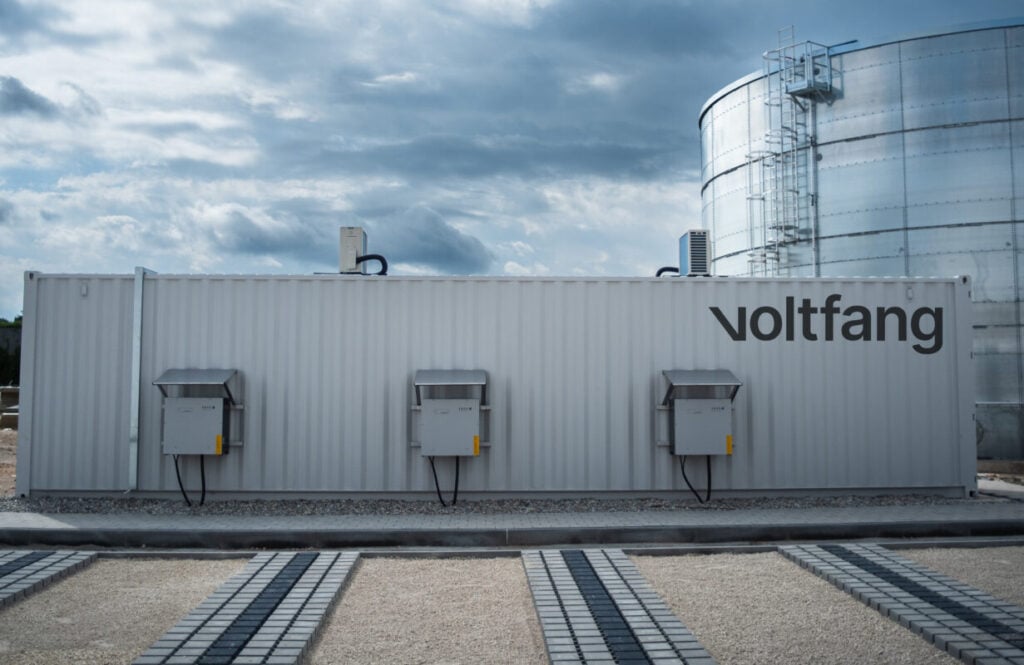
We catch up with executives from second life specialist BESS integrator Voltfang and investor Palladio Partners to discuss their recent €250 million (US$293 million) partnership to deploy projects in Germany.
The two companies announced the deal a fortnight ago (19 September), combining Voltfang’s experience in deploying battery energy storage systems (BESS) with Palladio’s financing and asset management capabilities.
Partnership
The agreement is for Voltfang to develop, build and operate the grid-scale BESS projects which Palladio then acquires and finances at the ready-to-build (RTB) stage, said Oliver Sauer, partner at Palladio Partner.
Voltfang has primarily focused on the commercial & industrial (C&I) market to-date, and its move into the front-of-meter (FTM) grid-scale segment needed a financial partner because of the completely different way projects are financed.
Try Premium for just $1
- Full premium access for the first month at only $1
- Converts to an annual rate after 30 days unless cancelled
- Cancel anytime during the trial period
Premium Benefits
- Expert industry analysis and interviews
- Digital access to PV Tech Power journal
- Exclusive event discounts
Or get the full Premium subscription right away
Or continue reading this article for free
“Developing and doing EPC work on FTM projects however is not new for us,” Voltfang founder and CEO Roman Alberti says. “In the beginning we mainly used our behind-the-meter (BTM) installer network but after a while we did more and more ourselves. A 100kWh can be done by an installation partner, but going to 600kWh, or 800kWh, or 2MWh, that is scale where a normal BTM installer cannot do that.”
The financing and regulation side are things that are newer too. Voltfang will reach commercial operation on a 20MWh project in one month’s time, and another at 5MWh, though these are not part of the Palladio partnership.
The partnership will focus on roughly 20MWh to 50MWh in size, and the first projects will come online next year, however the firm is not revealing how much they could deploy via the partnership.
Voltfang is also deploying projects for the Triodos Energy Transition Europe Fund in partnership with developer Icecreek Energy, totalling 16.6MW/35.6MWh, Triodos said last week.
Timing for the deal
“We want to deploy our money before potential regulatory change in 2029,” Sauer said on the timing of the partnership.
This is of course referring to the grid fees for importing and exporting power on the grid in Germany. In 2023, the German parliament voted on an energy law that extended an exemption of the grid fees for BESS to August 2029. That means if projects are online by then, they are exempt from the fees for 20 years.
The picture for projects coming online after that is not yet clear, with discussions around a more permanent solution ongoing. It basically means that all the current grid-scale BESS activity in Germany is for projects set for operation by that date, meaning much larger projects with lengthier delivery timelines are on the back burner.
Second life BESS approach
Voltfang is an RWTH Aachen University spin-out which has to-date specialised in repurposing electric vehicle (EV) batteries into stationary BESS, so-called ‘second life’ BESS. The firm raised €5 million in 2023, €15 million in a Series B earlier this year and opened a BESS assembly facility in Aachen, North Rhine-Westphalia (NRW).
However, like some other second life firms Voltfang has had to pivot to using new or at least unused EV batteries. Alberti says this is because of a lack of available true second life battery modules.
“When we started, we really wanted to enable second life, but what we see now in the market is that it’s very tough to get real second life modules. So we have a lot of new life modules which haven’t been integrated in the cars, so they are easier to finance, they’re easy to go into the market and they are just available for us,” Alberti said.
“In this deal, we can use either real second life batteries, new ‘second life batteries’ or new ones manufactured for energy storage, from China. All are possible, it depends from deal to deal and on our supply chain.”
“We like this duality,” Sauer said. “It can have an upside on price. But also, we are an Article 9 fund and we have an ambition to integrate circularity concepts into our investments.”
Whichever battery module they go for, Albert says the firm’s core competence is seeing how long batteries can last and how long they can go for. How much value it can add in this way for new batteries is limited, he says, but batteries from OEMs in Germany have a big role to play in assessing the batteries.
Other second life firms, including Finnish firm Cactos, have pointed out that second life is difficult mainly because of the rapid price falls from Chinese suppliers.
Alberti concedes that falling prices from new batteries is a challenge for the industry, but that things could easily change in two or three years time.
And second life batteries are cheaper than first life, he says, but the extra manufacturing and assembly needed compared to first life is what can make them overall more expensive for the end-consumer. And overall it is just more of a challenge.
“It’s of course more difficult to integrate second life batteries in all terms. Whether that’s for Voltfang, which is taking care of the battery and maximising its lifetime, or for Palladio to get the warranty and financing. Doing this helps Europe’s industry independence, but it’s a harder route, with more education needed,” Alberti said.
And unfortunately, while the EU Batteries Regulation should boost Europe’s battery recycling sector, it doesn’t appear at this point to have any direct benefits for the second life BESS industry.
